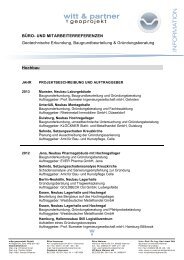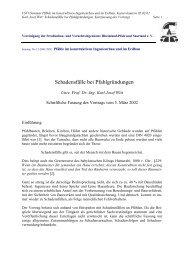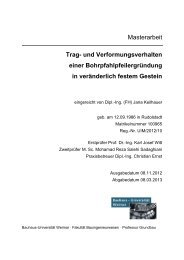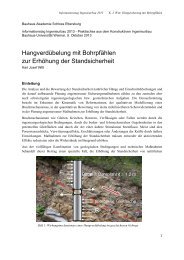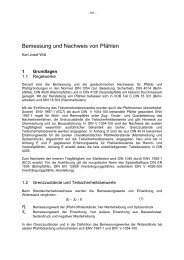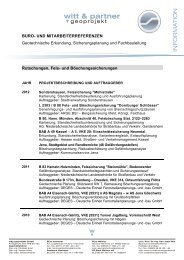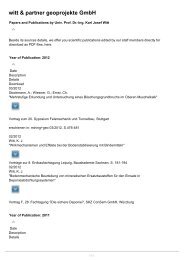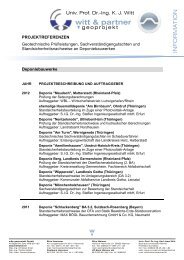A Static Analysis of Hydraulic Heave in Cohesive Soil - witt & partner ...
A Static Analysis of Hydraulic Heave in Cohesive Soil - witt & partner ...
A Static Analysis of Hydraulic Heave in Cohesive Soil - witt & partner ...
Create successful ePaper yourself
Turn your PDF publications into a flip-book with our unique Google optimized e-Paper software.
critical gradient [-]<br />
1e+4<br />
1e+3<br />
1e+2<br />
1e+1<br />
1e+0<br />
Dp = 0,002 m<br />
0 2 4 6 8 10 12 14<br />
cohesion [kN/m²]<br />
Davidenk<strong>of</strong>f<br />
Rehfeld<br />
Müllner<br />
Zou<br />
Figure 2. Comparison <strong>of</strong> erosion criteria accord<strong>in</strong>g to Davidenk<strong>of</strong>f [3],<br />
Rehfeld [5], Müllner [6] and Zou [10]; different percolated material<br />
and constant filter material<br />
Davidenk<strong>of</strong>f [3]<br />
Rehfeld [7]<br />
Müllner [6]<br />
Zou [10]<br />
6 c'<br />
FoS =<br />
tan ϕ'<br />
⋅ D ⋅<br />
c'<br />
FoS = 3<br />
2 ⋅ tan ϕ'<br />
⋅ D ⋅<br />
p<br />
p<br />
( γ ⋅ i − γ'<br />
)<br />
w<br />
6.<br />
2 c'<br />
FoS =<br />
D p<br />
⋅ i ⋅ γ<br />
( γ ⋅ i − γ'<br />
)<br />
w<br />
w<br />
( σ − γ ⋅ D ⋅ i)<br />
4 c' +<br />
x0<br />
w<br />
FoS =<br />
⎛ γ<br />
w<br />
2 ⋅ζ<br />
p +<br />
⎜<br />
⎝ T1<br />
p<br />
⋅ tan ϕ'<br />
⎞<br />
⋅ i − γ'<br />
⎟ ⋅ D<br />
⎠<br />
While the derivation <strong>of</strong> their erosion criteria the authors<br />
consider <strong>in</strong> [3], [5] and [6] the shear parameters ϕ’ and c’,<br />
the equivalent pore diameter <strong>of</strong> the filter soil D p and the<br />
gradient <strong>of</strong> the contact plane between the cohesive<br />
material and the filter soil relative to horizontal l<strong>in</strong>e,<br />
represented by the angle α. The context shown <strong>in</strong> formula<br />
(1) to (4) is significant for an upward flow out <strong>of</strong> the<br />
percolated soil <strong>in</strong>to the filter layer. Accord<strong>in</strong>g to the<br />
p<br />
approach <strong>of</strong> Zou a consideration <strong>of</strong> the pressure state is<br />
possible. In formula (4) he considered the effective lateral<br />
pressure σ x0 and the shear<strong>in</strong>g stress with<strong>in</strong> the erosion<br />
capillary ζ · p. A factor T 1 is def<strong>in</strong>ed to consider the fabric<br />
<strong>of</strong> the soil.<br />
Assum<strong>in</strong>g a safety factor <strong>of</strong> FoS = 1 the erosion criteria<br />
mentioned above are plotted <strong>in</strong> Fig. 2 as function <strong>of</strong> the<br />
critical gradient depend<strong>in</strong>g on cohesion for an upward<br />
directed flow. Constra<strong>in</strong>ts <strong>of</strong> the calculations were a<br />
constant friction angle (ϕ’ = 25°) represent<strong>in</strong>g the<br />
percolated soil and a constant equivalent pore diameter<br />
(Dp = 2 mm) represent<strong>in</strong>g the distance between the<br />
particles <strong>of</strong> the filter layer. The safety aga<strong>in</strong>st erosion and<br />
the result<strong>in</strong>g critical gradient are valid for the surface <strong>of</strong><br />
contact between the percolated soils as well as for the<br />
filter layer. At the same time the weight <strong>of</strong> the filter layer<br />
causes a stress <strong>in</strong> the contact pla<strong>in</strong>.<br />
The comparison <strong>of</strong> the presented criteria show a strong<br />
<strong>in</strong>crease <strong>of</strong> the critical gradient even with moderate ris<strong>in</strong>g<br />
cohesion. The functions describ<strong>in</strong>g the critieria <strong>of</strong><br />
Davidenk<strong>of</strong>f, Rehfeld and Müllner are look<strong>in</strong>g similar.<br />
Simplify<strong>in</strong>g the formulas leads to the def<strong>in</strong>ition <strong>of</strong> a<br />
straight l<strong>in</strong>e with different gradients. The root <strong>of</strong> the<br />
formulas, that is the <strong>in</strong>tersection <strong>of</strong> the graph and the axe<br />
<strong>of</strong> the critical gradient, is at a value <strong>of</strong> 1 for the criteria <strong>of</strong><br />
Davidenk<strong>of</strong>f and Rehfeld and zero for the formula<br />
accord<strong>in</strong>g to Müllner. Zou’s erosion criterion is<br />
recognisable due to its different shape (see Fig. 2). In a<br />
range <strong>of</strong> small cohesion (c’ ≤ 10 kN/m²) the critical<br />
hydraulic gradient is much higher compared to the other<br />
erosion criteria under the state <strong>of</strong> stress considered <strong>in</strong> his<br />
paper (see [10].)<br />
With<strong>in</strong> the scope <strong>of</strong> different experiments Leuss<strong>in</strong>k [5]<br />
(1) studied the <strong>in</strong>fluence <strong>of</strong> a vary<strong>in</strong>g f<strong>in</strong>e particle content <strong>of</strong><br />
soils with small cohesion (c’ < 5 kN/m²) with regard to<br />
strength and stiffness <strong>of</strong> soil mixtures. Besides the<br />
exam<strong>in</strong>ation <strong>of</strong> the shear strength and the pore pressure <strong>in</strong><br />
wide graded soils the experiments were focused on the<br />
safety aga<strong>in</strong>st erosion. Fig. 3 shows experimental<br />
(2) <strong>in</strong>vestigated failures accord<strong>in</strong>g to the permeability and the<br />
hydraulic gradient. In detail the po<strong>in</strong>ts <strong>in</strong> the figure mark a<br />
partially or total failure <strong>of</strong> the soil body by erosion <strong>of</strong> the<br />
f<strong>in</strong>e particle content. They are generalised as a function.<br />
Assum<strong>in</strong>g that cohesion and permeability are related<br />
<strong>in</strong>direct proportional it can be derivated that soils with less<br />
or quasi zero cohesion, respectively relative pervious<br />
(3) (3)<br />
(4)<br />
permaebility [m/s]<br />
1e-2<br />
1e-3<br />
1e-4<br />
1e-5<br />
wash<strong>in</strong>g<br />
c' ~ 0 to 10 kN/m²<br />
1e-6<br />
0 2 4 6 8 10 12<br />
hydraulic gradient [-]<br />
Figure 3. Correlation between permeability and critical gradient <strong>of</strong> soils<br />
with small cohesion [5]



